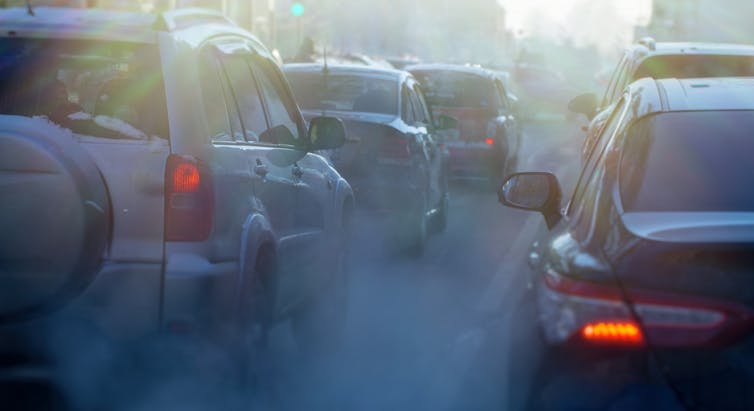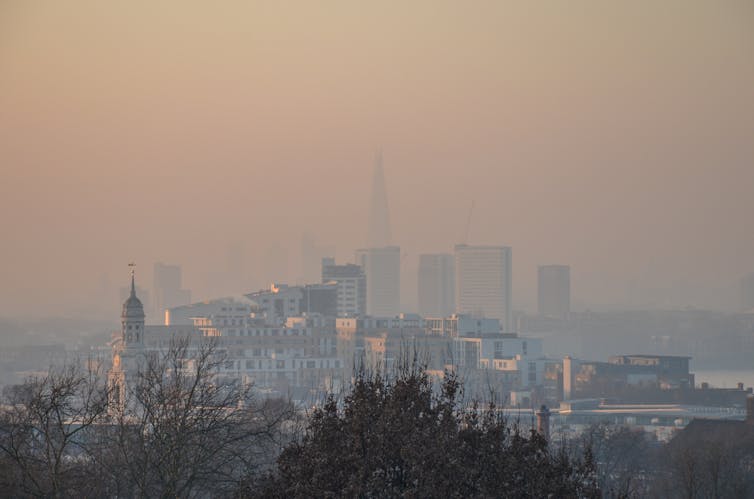Suzanne Bartington, University of Birmingham and Roy Harrison, University of Birmingham
The combined effect of indoor and outdoor air pollution is estimated to cause seven million early deaths each year worldwide. The most harmful pollutants include nitrogen dioxide (NO₂) and fine particulate matter, or PM2.5 – particles smaller than 2.5 micrometres – which can penetrate deep into the lungs and enter the bloodstream.
Exposure to particulate pollution over years or decades can reduce a person’s life expectancy, mainly due to the increased risk of heart and lung diseases. Even short-term exposure, over hours or days, can increase the risk of hospital admission.
How far would air pollution levels need to fall in order to ensure people aren’t adversely affected? Much further than the limits currently imposed in many countries, including England, according to new Global Air Quality Guidelines released by the World Health Organization (WHO).
The new guidelines draw from major advances in air pollution research since the previous update in 2005. After examining more than 500 academic articles, WHO researchers have concluded that stricter limits on air pollution are necessary to protect human health.
The WHO has reduced its annual recommended limit for PM2.5 from ten to five micrograms per cubic metre. Recommended limits on NO₂ have also been tightened – from 40 to ten micrograms per cubic metre. New guideline limits have also been introduced for ozone during warmer months, when concentrations peak, and for daily NO₂ and carbon monoxide levels, in light of new evidence of short-term health effects. Interim targets have also been provided to help governments work towards the new guideline levels.
The WHO update was informed by several epidemiological studies which have indicated that PM2.5 exposure can affect health even at low levels, including below the previous WHO yearly guideline limit of ten micrograms. Studies also suggest there may be no safe threshold for exposure to particulate pollution.

The new guidelines focus on exposure to single pollutants. But in everyday life we’re exposed to a mixture – and scientists do not yet fully understand how these interact to affect a person’s health.
Reforming air quality laws
While tighter air quality guidelines are encouraging news for public health, they are only intended to inform the setting of legally binding targets – they cannot guarantee legislative or policy changes on their own. Regulating air pollution is complex, and measures differ in scope and scale, and what works in one setting may be less effective in another. At a global level, no common framework exists to regulate the most harmful air pollutants beyond those released by shipping and aviation. Yet, almost all of the world’s population – more than 90% according to WHO estimates taken in 2019 – is breathing harmful, polluted air.
The new guidance offers an opportunity for high-income countries such as the UK to prioritise the protection of public health from air pollution. Air quality objectives are established nationally as a devolved matter in the UK. The current legally binding limit for PM2.5 in England is 25 micrograms per cubic metre. This is currently under review in the Environment Bill, which promises to refer to “WHO guidelines when setting air quality standards”. An amendment which would commit the UK government to reducing PM2.5 in England to at least the 2005 WHO guideline levels of ten micrograms by 2030 was recently approved in the House of Lords.

The new guidelines have profound implications for the policy debate in the UK. The UK was likely to achieve the 2005 guidelines for NO₂ and PM2.5 pollution within a few years, but the new guidelines cannot be met without huge reductions in emissions.
Replacing internal combustion engines with electric batteries in much of the country’s vehicles would go a long way towards meeting the NO₂ guideline limit. But this will take many years, and it will have little, if any, benefit for PM2.5 pollution. Natural sources of particulates, such as sea salt and soil dust, already account for around three micrograms per cubic metre in the southern UK, leaving little room for anthropogenic sources.
The new WHO guidelines provide a strong incentive for more ambitious policies. Hopefully governments will act accordingly, prioritising public health and the environment when setting standards for cleaner air.
Suzanne Bartington, Clinical Research Fellow in Environmental Health, University of Birmingham and Roy Harrison, Queen Elizabeth II Birmingham Centenary Professor of Environmental Health, University of Birmingham
This article is republished from The Conversation under a Creative Commons license. Read the original article.












